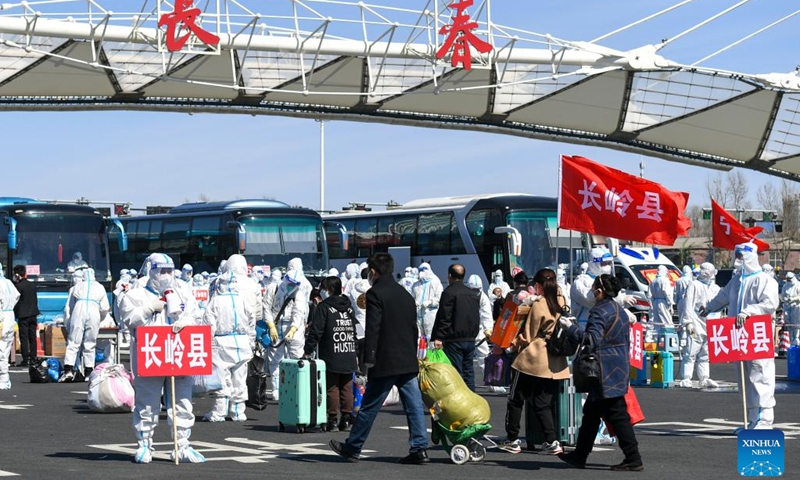
Farmers returning home for spring farming line up to board the chartered buses at a highway exit in Changchun City, northeast China's Jilin Province, April 12, 2022. Northeast China's Jilin Province, a major grain producer now fighting a COVID-19 outbreak, is issuing travel passes for farmers and sending them to farmland in chartered buses. By Sunday evening, around 100,000 farmers had reached their destinations.(Photo: Xinhua)
Spring planting in China's northeastern region, where grain output accounts for one-fifth of the country's total, is gaining steam despite setbacks caused by COVID-19. With agricultural materials and workers gradually moving into place, farming activities are progressing smoothly, local growers told the Global Times.
At a press conference on Thursday, officials from Northeast China's Jilin Province underscored the efforts to smooth out the transport and supply of agricultural materials, and ensure that farmers have access to the fields, so that farming time is not delayed for a day and not even a hectare of land is left unused.
As a major grain-producing province, Jilin has a grain output of about 40 billion kilograms, which is crucial to ensuring national food security. It is also the country's second-biggest corn-growing province.
Gao Guangyong, a corn grower based in Jilin's Dongfeng county, told the Global Times on Thursday that preparations for spring plowing in Jilin are proceeding in an orderly manner.
"Some fields are being prepared to plant corn, while for rice, planting has already started in a few areas. But most of the areas are not suitable for early sowing because of local weather conditions," Gao said.
Since the beginning of April, the Jilin provincial government has implemented a series of policies to ensure spring farming to clear blockages in the distribution of agricultural materials and flow of personnel, cancel unnecessary checkpoints, and organize chartered vehicles to transport farmers to the fields.
"With materials and personnel basically in place, there will be no major delays in the progress of spring farming and this year's grain output is expected to be guaranteed," said Gao, who provides agricultural services for more than 1,000 mu (66.7 hectares) of land in Jilin, and he himself has farmland of 100 mu as well.
As an increasingly important grain bowl for the country, Northeast China has ramped up efforts in soybean and oil crop plantation in addition to rice and corn.
In Northeast China's Heilongjiang Province, the country's leading soybean production base with planting area taking up more than 40 percent of the country's total, growers are actively preparing to sow the key agricultural commodity, in an effort to ensure domestic self-sufficiency of soybeans for making edible soybean products.
"Encouraged by the national favorable policies in soybean planting expansion, coupled with the good soybean market thanks to robust domestic demand for oil crops, farmers around me have become more motivated to plant soybeans," said Gai Yongfeng, chairman of Jiaxing Modern Agricultural Machinery Professional Cooperative in Heihe, Heilongjiang Province.
"This year, our cooperative plans to farm 35,000 mu of arable land and plant 25,000 mu of soybeans, an increase of 9,000 mu over last year. It is expected that this year's output will more than double from 2021," Gai, who was awarded the title of "King of Soybean Production" in Heilongjiang, told the Global Times on Thursday.
Although epidemic prevention and control measures have had some impact on the preparations for spring plowing, the preparation work has gone back to normal and gained speed, Gai said, noting that soybean planting will start from the beginning of May.
Heilongjiang has set a target of adding 10 million mu of soybean plantation area this year, and an increase of 1.3 billion kilograms of grain from last year.
Local firms and cooperatives are implementing the nation's plan of launching pilots to transform paddy fields into dry land in order to divert rice to soybean planting, particularly in areas where farmers excessively rely on exploiting underground water for irrigation.
Beidahuang Group, one of the nation's largest agricultural and agribusiness groups based in Heilongjiang, has taken the initiative to expand soybean planting, and it plans to increase its soybean planting area by more than 2.3 million mu in 2022.
The National Development and Reform Commission, China' s top economic planner, has detailed tasks to boost agricultural production, urging vigorous efforts to expand the planting of soybean and oilseed crops to effectively stabilize and increase grain self-sufficiency.
Apart from the northeast part of China, the central government also aims to expand the planting of corn and soybeans in its east, northwest and southwest regions.
Soybeans and corn have been the top import grains for China in recent years. Data from the General Administration of Customs showed that China imported 164.54 million tons of grain in 2021, equivalent to 24 percent of its grain output.
China aims to ensure that the grain output for 2022 stays above 650 billion kilograms, according to this year's government work report.




